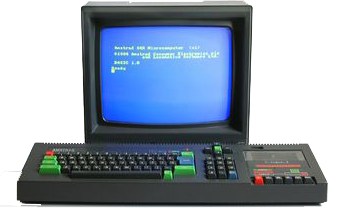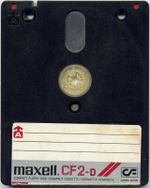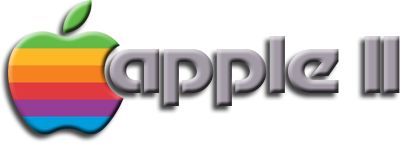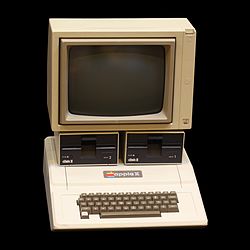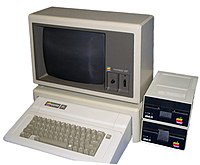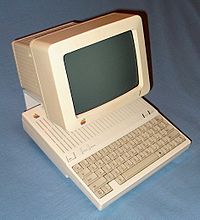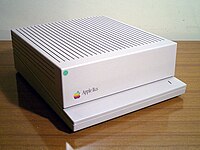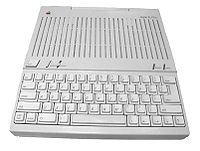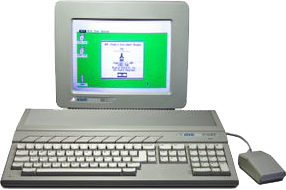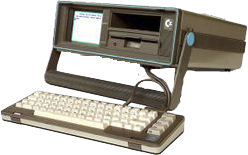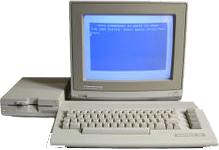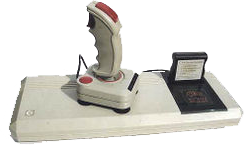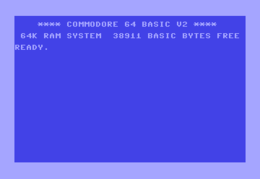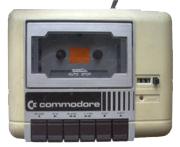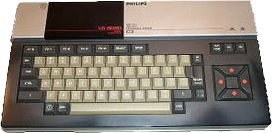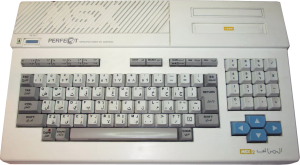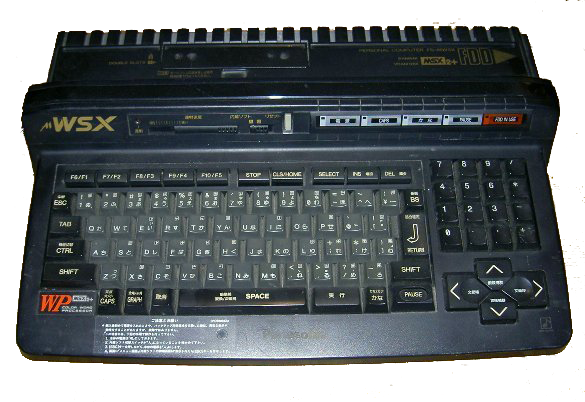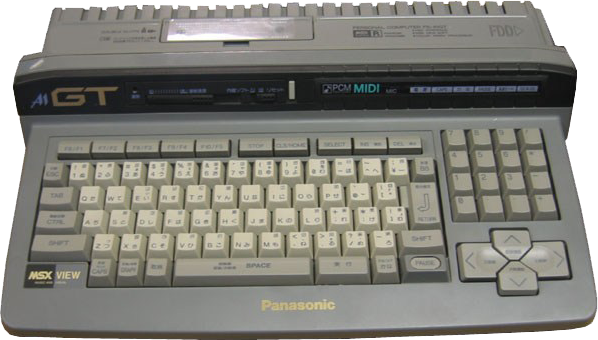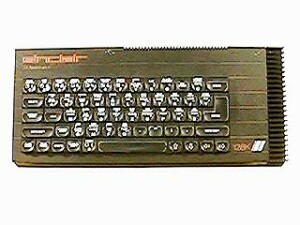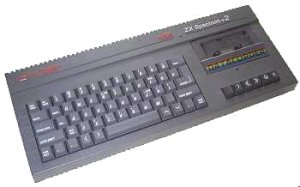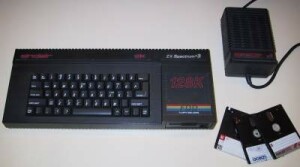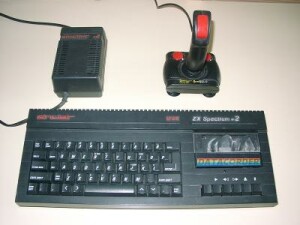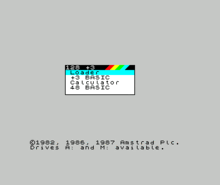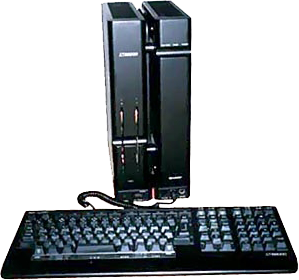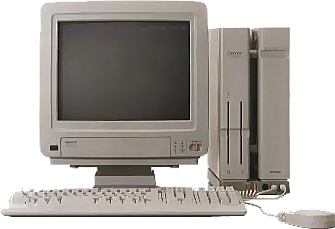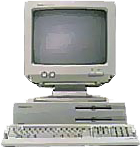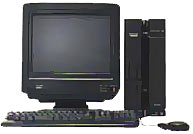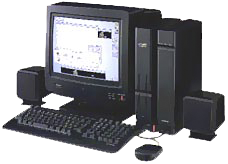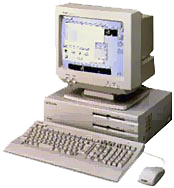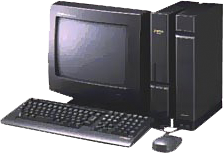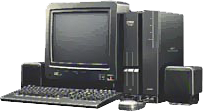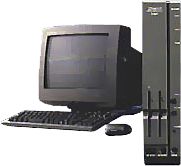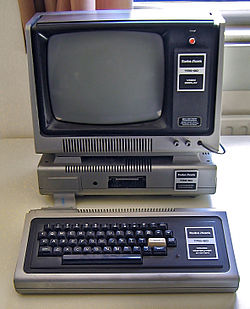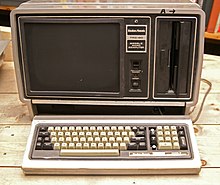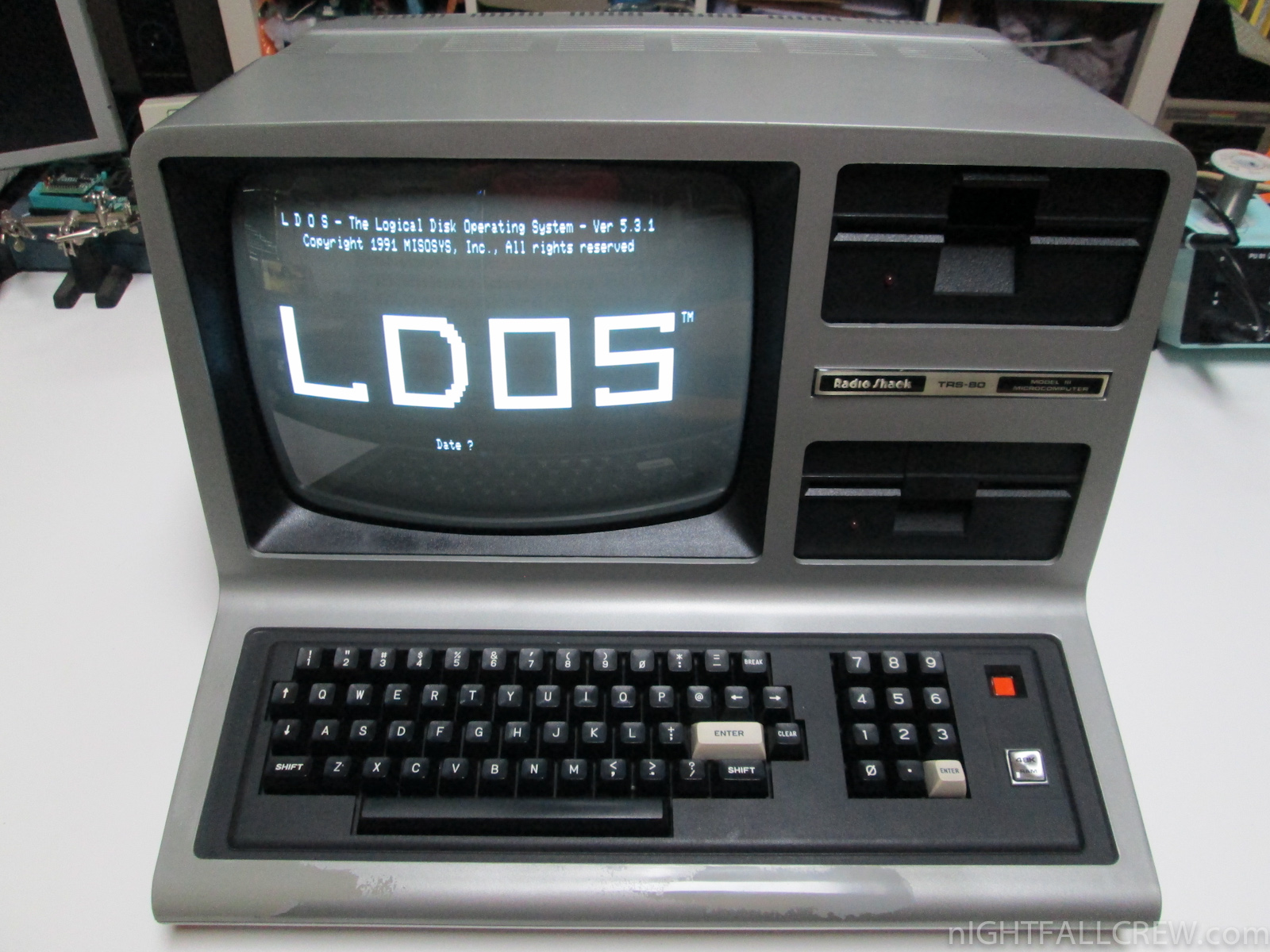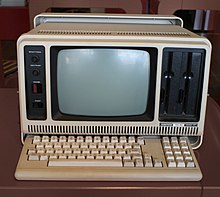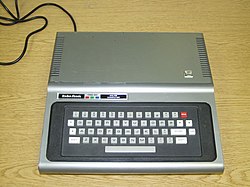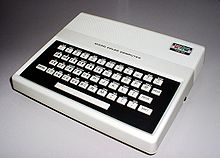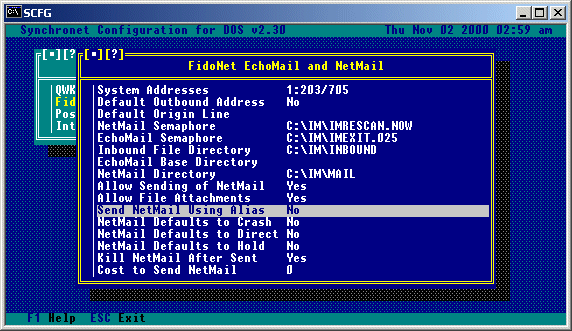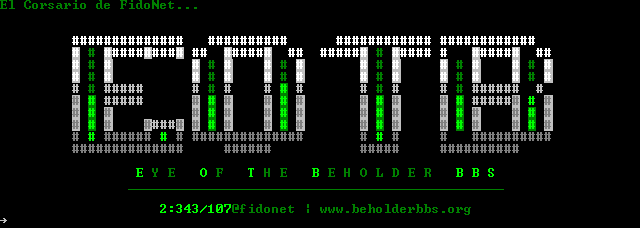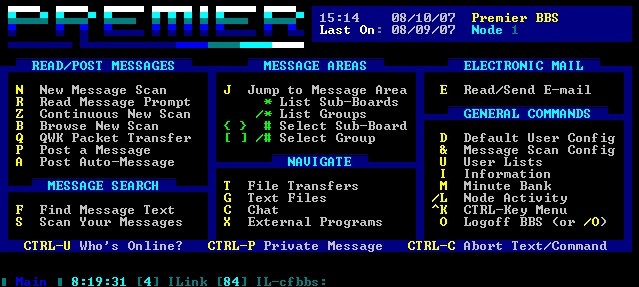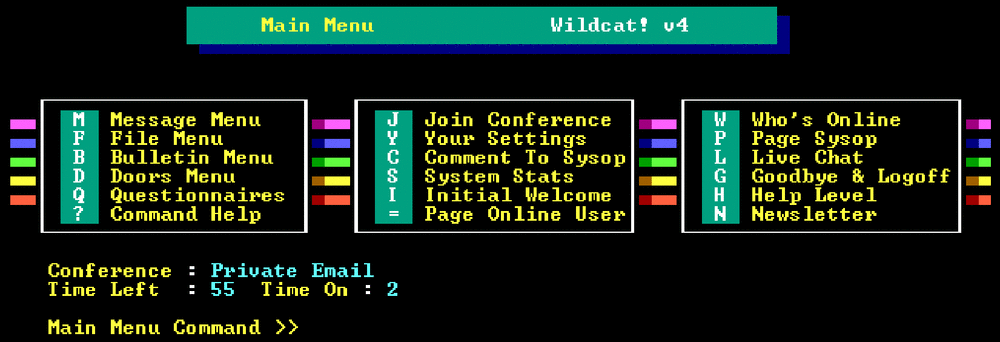Commodore Amiga
Friend of mine is a family of personal computers originally developed by Amiga Corporation as an advanced game console

Amiga's development began in 1982 with Jay Miner as the lead hardware designer
Commodore International introduced the computer to the market in 1985, having purchased Amiga Corp
The computer was ahead of its time, sporting custom chipset with advanced graphics and sound, and with a sophisticated multitasking operating system, now known as AmigaOS
Description
Based on the Motorola 68k 32 bit microprocessor, Amiga provides a significant improvement to 8 bit computers, Commodore 64 and Amiga quickly grew in popularity among computer enthusiasts, especially in Europe
We also found a prominent role in the professional video editing
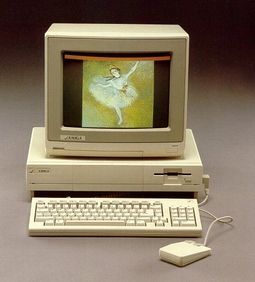
History
Amiga Corporation
The Amiga Chipset was designed by the small company called Amiga Corporation during the end of the first home gaming boom
Considering industrial espionage, the chipset tube as Lorraine development code
Amiga Corp. financed the development of Lorraine by manufacturing joysticks while seeking investors
The chipset was to be used in a video game machine that required a lot of processing power, memory, CPU bandwidth, audio and video hardware
But after the video game crash in 1983, Lorraine was reused to be a high-performance personal computer to which an operating system with a good keyboard was added
Before the computer could be brought to market, Amiga Corp. ran into financial difficulties and was purchased by Commodore in August 1984
Commodore
The first Amiga computer, simply called Amiga (and conspicuously lacking references to Commodore), was released in 1985 by Commodore, which marketed it as the successor to Commodore 64 and as its competitor against Atari ST
The name was later changed to Amiga 1000 (or A1000 for short)
It was revolutionary for its time, as it could display 4.096 colors and produce 4 channels of 8 bit stereo digital audio
It was also notable for having the first preemptive multitasking operating system with a colorful GUI, allowing users to perform multiple tasks at the same time
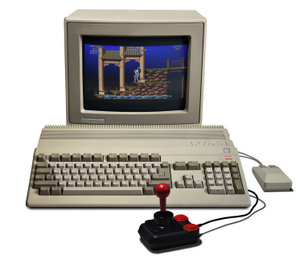
In 1987, Commodore launched two new Amiga models, the A500 and the A2000, which were marketed as low-end and high-end computers, respectively
The former became the most popular Amiga computer of the decade and was used primarily as a gaming machine, while the latter was used as a more serious workstation, for graphics uses, due to the presence of a SCSI controller, a Genlock slot and a video I/O connector
In 1990, A3000 was introduced as the successor to both the A1000 and A2000, with an enhanced chipset (ECS) and the second version of its operating system, which would eventually be called AmigaOS
In the same year, Commodore launched three new low-end machines: the CDTV, intended to move the platform into the living room; A500+, with the same improvements as A3000; and A600, basically an A500+ in a smaller case with an IDE hard drive controller
All were commercial failures, mainly due to a poor marketing campaign
Amiga computers at the time were considerably cheaper than the PC or Mac
This factor helped boost sales in more price-conscious European markets, but also hurt Commodore, which was seen in U.S. markets as a producer of “cheap gaming machines”
This perception was encouraged by the fact that most Commodore outlets were in toy stores, and the marketing campaigns did not match the American public
The Amiga was very successful in Europe, but sold less than a million units in the US
In 1992, Commodore released the latest Amiga computer models, A1200 and A4000
Each featured the new AGA-chipset and the third release of AmigaOS
In 1993, threatened by console giants Sega and Nintendo, Commodore released the CD32 in a desperate attempt to save its business
The CD32 was one of the first CD-based consoles and was also the world's first 32 bit gaming machine, with similar features to the A1200
Bankruptcy
Commodore's bankruptcy in 1994 seriously slowed the growth of the Amiga
Production was briefly halted, until restarted for a short time under Amiga Technologies for Escom, a German PC maker
Although the machines had been updated and had extensive hardware and software support, the absence of new Amigas models caused suppliers to stop selling them
The majority of the fans to the cutting edge technology and the market moved to the architecture of the PC
Due to the fierce loyalty of some Amiga fans, the “scene” continued for many years even after the last original Amiga was sold
Inevitably, the PC became the leader in home computing, and in the world of consoles they also left the CD32 behind
In 2000, the rights to the Amiga platform were sold successively to Escom and Gateway 2000, but neither of them managed to do much with them
Rumor has it that it was due to pressure from Microsoft; However, the true reason for the sale is not known
Eventually, an entirely new company called Amiga, Inc. (no relation to the original Amiga Corporation) was founded to manage the Amiga product line
Although Amiga, Inc. paid much more attention to the Amiga product line than Escom or Gateway 2000, due to low demand in the mainstream market, development was slow and sales poor
In 2002, Eyetech in cooperation with Amiga Inc, released a limited number of AmigaOne
It was a new motherboard based on MAI's Teron POP (PowerPC Open Platform) based designs, and allowed AmigaOS 4 to run
The original motherboard based on the G3 was replaced by a new design with a CPU module replaceable, which came in G3 and G4 flavours
In 2004, a micro ATX model was released with a 750GX G3 CPU
Due to the AmigaOne's radical departure from previous Amiga designs with their custom chipsets, older machines are often referred to as classic Amigas, to distinguish them from PowerPC-based AmigaOnes
Amiga, Inc.
The current owner of the brand, Amiga, Inc., has since 1993 licensed the rights to make hardware using the Amiga brand to a UK equipment supplier, Eyetech Group, Ltd., which was founded by some former UK employees. Commodore International Kingdom
Eyetech withdrew from the Amiga market in 2005 and subsequently sold the remainder of the Amiga business to Kit Amiga, which is involved in international network distribution
In 2007, Amiga, Inc. sued the belgian-german company Hyperion Entertainment, a company developing AmigaOS 4 for AmigaOne boards for trademark infringement in the Western District Court of Washington in Seattle, USA
The company claimed that Hyperion had breached the contract, citing trademark and copyright infringement in connection with the development and marketing of AmigaOS 4.0
On September 20 of 2009, Amiga Inc and Hyperion Entertainment reached an agreement granting Hyperion an exclusive, perpetual, worldwide right to AmigaOS 3.1 to use, develop, modify, market, distribute and market AmigaOS 4.x and versions later AmigaOS (including AmigaOS 5)
In 2010, Commodore USA announced that it acquired the rights to the Amiga name and relaunched Amiga-branded desktops with AROS and Linux, which, however, Hyperion Entertainment quickly disputed, based on a 2009 settlement agreement between Hyperion and Amiga. Inc.
After legal threats from Hyperion due to the terms of Amiga Inc.'s agreement with them being bound as Amiga licensees, Commodore USA abandoned their plans with AROS and announced on their website that they would create a new operating system called AMIGA Workbench 5.0 (the name changed to Commodore OS as Workbench was owned by Cloanto), which was later revealed to be based on Linux
In 2011, Amiga Inc. licensed the brand to Hong Kong-based manufacturer IContain Systems, Ltd.
In 2012, Amiga Inc. completed the transfer of copyrights through 1993 to Cloanto
On February 1, 2019, Amiga Inc. transferred all of its intellectual property (including the Amiga trademarks and remaining copyrights) to C-A Acquisition Corp., owned by Mike Battilana (director of Cloanto, company behind the emulation package Amiga Forever) later renamed Corporación Amiga
On March 30, 2023, the dispute between Amiga Inc. and Hyperion was resolved, due to the release of Workbench 3.1.4 by Hyperion
Very few Amiga clones were produced, as both the Commodore and the following brand owners refused to license Amiga technology to third parties
Today, Amigas running AmigaOS version 3.9 and earlier are considered the “Amiga Classics,” as opposed to the newer Amiga Inc./Eyetech/Hyperion models
Due to its popularity as a gaming platform, many people incorrectly refer to the Amiga as a gaming console (even though it is a fully functional computer)
However, there are many “Amiga Classics” still operating around the world
A popular use for “Amiga Classics” is as an automated readerboard (visual presentation board that conveys information on a wide variety of topics, including advertising products or services, travel, news or event information) for local community access to TV channels
AmigaOne
After the bankruptcy of MAI Logic Inc, Eyetech ran out of supplies to continue production and what was going to be the fourth device in the series (MicroA1-I) was cancelled
Therefore, it became difficult to obtain an AmigaOne
Models are not official
Subsequently, other manufacturers launched motherboards with PowerPC CPUs on which Genesi's AmigaOS 4.1: Pegasos2 can also be installed (AmigaOS 4 support since January 2009), already discontinued and Sam440ep and Sam460ex from ACube Systems Srl (support since October 2008), even in manufacturing
AmigaOne X1000
La empresa A-EON anunció en enero de 2010 el futuro AmigaOne X1000, con CPU PowerPC doble núcleo 64-bits P.A. Semi PWRficient PA6T-1682M y coprocesadores XMOS XCore
A-EOn has agreements with Hyperion, Varisys and AmigaKit
Production was announced to begin in summer 2010, but was delayed, initially to at least late 2010, and again to 2011
It was expected to be available at the end of 2011, although it was finally delayed again
At the end of January 2012, A-EON announced that the first batch of units were beginning to be sent to customers (which they called the “First Contact” batch)
It stopped manufacturing in 2015 due to the shortage of the PA6T CPU
AmigaOne 500
Acube Systems announced in October 2011 a computer based on its Sam460ex board under the name AmigaOne 500, which began selling soon after
AmigaOne X3500 and X5000
In January 2014, A-EON announced that the new X3500 and X5000 models were in development, based on Freescale QorIQ P3 and P5 series CPUs
Sales of the X5000/20 began in October 2016 with the QorlIQ P5020 CPU
Clones of Amiga hardware
DraCo
Amiga developer MacroSystems has long entered Amiga clones on the market with its DraCo non linear video editing system
It appeared in two versions, initially a tower model and then a cube model
DraCo expanded and combined a series of expansion cards previously developed for the Amiga (VLabMotion, Toccata, WarpEngine, RetinaIII) into true Amiga clones with Motorola's 68060 processor
DraCo could run AmigaOS3.1 through AmigaOS 3.9
It is the only system based on the Amiga that supports FireWire I/O video
DraCo also offered an Amiga-compatible ZORRO-II expansion bus and introduced a faster custom DraCoBus, capable of transfer rates of 30 MiB/sec (faster than Commodore's ZORRO-III)
The technology was later used in the Casablanca system, a set-top-box also designed for non linear video editing
Access
En 1998, Index Information lanzó el Access, un clon de Amiga similar al A1200, pero con una placa base que podía caber en un compartimiento de unidad estándar de 5 1/4"
It featured a 68020 or 68030 CPU, with a redesigned AGA chipset, and could run AmigaOS 3.1
Minimig
In 2006, two new Amiga clones were announced
Minimig was a personal project of Dutch engineer Dennis van Weeren
Minimig replicated the chip custom Amiga OCS within a FPGA
The original model was built on a Spartan 3 development board, a dedicated board has now been demonstrated
The source code and schematics were released under version 3 of the GNU General Public License on July 25, 2007
On December 23, 2007, the Italian company ACube Systems Srl announced that it would market the Minimig board
The first version had a real 3.3v 68000, a PIC to load the FPGA program and also to read MMC cards
Required an A500 ROM image (either 1.x,2.x,3.x) to work
Clone-A
Individual Computers announced the development of the Clone-A system, showing it as a prototype, starting in mid-2007, FPGA-based boards that replaced the custom tokens of a Amiga 500
BlizzardPPC y CyberstormPPC
Phase5 BlizzardPPC (for Amiga 1200) and Phase5 CyberstormPPC (for Amiga 3000 and 4000) from 1997-2000 that allowed a PowerPC CPU to be installed in “Amiga Classics”
A version of AmigaOS 4.0 was released in July 2007 exclusively for machines with BlizzardPPC and CyberstormPPC, updated in February 2008
Morphos 1.4.5 was previously released for these products
Pegasos
Pegasos was a machine manufactured by bplan GmbH and marketed by Genesi
It came out in 2 versions:
- Pegasos1: (with a 750cx/600Mhz and ArticiaS chipset from MAI), of which 3 versions were released. The first had DMA problems, and the next two were corrected with the chip called April. The last version with the April2 chip was finally very stable
- Pegasos2: (with Marvell chipset, DDR memory support and a G3/600Mhz or a G4/1Ghz, as well as 2 Ethernets). Both boards run LinuxPPC and MorphOS (a modern OS compatible with AmigaOS3.x, WarpOS, PowerUP and AmigaOS4 via a third-party emulator)
They are no longer produced, they were manufactured between 2002 and 2006. The Pegasos 2 (not the Pegasos 1) supported AmigaOS 4.1 since 2009
EFIKA 5K2
EFIKA 5K2 motherboard sold by Genesi with PPC Freescale 5200B CPU, after the Pegasos 2
Supports, among others, MorphOS and Linux
It was presented in 2005, it continued to be sold at Directron, a manufacturer that managed to reduce the price to $99
Sam440ep
It was a motherboard produced by the Italian company ACube Systems Srl that integrated a PPC AMCC 440EP CPU
It came out in 2 versions:
- ep with integrated graphics ATI Radeon Mobility M9
- ep-flex without integrated graphics. It supported AmigaOS 4.1, AROS, Linux and FreeBSD. Launched in 2007, manufacturing continued in January 2012
Sam 460ex
In April 2010 Acube announced that the new Sam460ex motherboard (with a more powerful CPU than the Sam440) would be available at the end of September 2010, but it was delayed
In November 2010 it was on sale for the industrial market for embedded computers with Linux and in March 2011 for the general public with AmigaOS 4.1
It did not replace the Sam440, although it was above the 440 in price and features
Acube would later announce a more affordable version, the Sam460ex-Lite (intermediate performance between the 440ep-flex and the 460ex) and a complete computer based on the Sam 460ex, the AmigaOne 500
Hardware
At the time of its release in 1985, the Amiga was the most advanced computer designed for the home market
It offered a fast CPU, enormous memory expansion capacity, powerful sound and graphics subsystems, and was the first personal computer with a multitasking operating system
It was more popular in the home than in the business environment, where it was used largely for its video editing capabilities
It never became the flagship product, and became obsolete in 1994 (something debatable), when Commodore International, its manufacturer, ceased operations
UPC
The first model, Amiga 1000, had a 7.14 MHz 68000 CPU, designed to work directly with NTSC video
The CPU clock frequency was just twice the 3.57 MHz color carrier frequency
A1000 had a composite video output, allowing the set to be connected directly to a TV or VCR
However, the output signal was considered too “hot” (powerful) to use for anything other than home use
This could be solved by running the A1000's composite output through a video processing amplifier, or "proc amp", to bring the video to appropriate levels
Chipset custom
The Original Amiga chipset (OCS), was the most advanced of the architectures of its time: it had dedicated chips for creating real-time video effects, allowing users to easily work with genlocks to overlay graphics on top of live video
The Amiga's overscan function, the ability for custom runs, user-defined resolutions, allowed images to be drawn beyond the visible edges of a television screen, allowing seamless fly-ins and out-of-frame panning
The original machine was extremely expandable, supporting a huge amount of memory for its time, 256K (and was used completely), and offered an initial expansion to 512K
This first 512K of memory was a RAM chip, which meant it was shared between the chipset and the CPU, with the chipset taking priority
Additional RAM, up to 8 megabytes, could be attached via a side expansion bus, and was visible only to the CPU
Just 8 megabytes may seem ridiculously small to a modern reader, but at the time, that amount of RAM would have cost about $10,000
Amiga had no text mode, offering only bitmap graphics
“Flat” graphics were used, which means that the screen memory buffers were organized in bitplanes
A 1-Bitplane image provided 2 colors (usually black and white): this would be the equivalent of early Macintosh display
Each Bitplane additional doubled the number of available colors
Low resolution mode supported up to 5 plans (and therefore 32 colors), while high resolution supported 4 plans (16 colors)
Each color could be chosen from the 4096 palette system
The flat layout was a bit difficult for the CPU to manipulate, since a particular pixel on the screen could be represented by more than 5 bytes scattered in memory
This problem was solved with the blitter, since it could be done automatically
To overcome color limitations, the Amiga also offered a unique HAM (Hold And Modify) graphics mode
In this low-resolution mode, a pixel could be used as any of the 32 basic colors, exactly the same as real low-resolution displays
Additionally, a particular pixel could H)old (hold) the value of the previous pixel, and M)odify (modify) each red, green or blue value
When this software was developed and images could be encoded in this way, a surprising set of incredibly realistic images began to circulate
This mode was difficult to program, so it was mostly used only for slideshows and layered video
The video chipset was very flexible, and was capable of doubling the basic resolution of the screen when switching to interlacing
It was designed to be used in televisions, so its signals were also intertwined
This allowed the Amiga was the first personal computer used for work with video applications
Additionally, arbitrary resolutions could be defined and used, drawing the extra pixels, if any, in the “overscan” area around the edges of the screen
Which allowed you to quickly and easily switch between NTSC and PAL resolutions; the same hardware was sold in both areas
By specifying large values for the overscan, the edges of almost all televisions could be exceeded
Which allowed objects to 'fly-in' outside the frame, and allowed its success in the video market
Many users liked the higher resolution display that interlacing offered, but despised the flickering
This provided a minority market for flicker fixers
Each “fixer” was just a piece of smoked glass attached with Velcro to the monitor; decreasing the contrast reduced the apparent flickering
Then there were hardware deinterlacers, and finally Commodore released versions of the Amiga that could produce higher resolutions natively
The Amiga's unique architecture, however, was a drawback in high-resolution modes
When more than four colors were presented in high resolution, the chipset required more and more memory bandwidth
In 16 colors, CPU access is slowed down, reducing the machine speed by more or less half
For this reason, high-resolution 16-color displays were avoided in the Amiga's evolution until later, when RAM expansions became routine
High resolution does not slow the RAM of the CPU
This led to it being commonly called “fast” RAM, as opposed to “chip” RAM which could be seen (and slowed down) by the graphics subsystem
Later Amiga models included enhanced chipset versions: Enhanced Chip Set (ECS) and Advanced Graphics Architecture (AGA)
The blitter
The blitter (block image transfer hardware) allowed fast copying of the video memory, freeing the CPU to perform other tasks
This was the beginning of today's graphics implementation, where the dedicated GPU (graphics processing units) operated independently, without supervision from the CPU
Therefore, the blitter allowed the programmer to create bobs (blitter objects) that were controlled with subroutines using control interrupts
The main thread of the program was not used to perform the redraw of the screen
The blitter could also draw lines the thickness of a single pixel, and fill large areas in uniform or stippled color (grading of solids or shadows using small dots), as well as screen blanking (erasing the screen with in order to draw it again) or draw 3D polygons
Blitter was never improved for rotations or zoom bobs, or for applying textures to polygons
When these graphics techniques became common (such as with the release of the SNES and Voodoo/ATI Rage graphics accelerators), the Amiga chipset quickly became obsolete
The copper
The copper was a relatively simple chip that executed a stream of programmed instructions, closely linked to the video hardware
Basically I could do two:
- wait: simply waits until a specific screen position is reached
- move: can write arbitrary values to the chipset, allowing, for example, instant palette changes in the middle of the screen
This also allowed the “reuse” of the sprites
The Amiga hardware engine supported only 8 sprites, but with the help of copper, it seemed like there were many more
Each sprite was drawn in a certain position, until the raster beam (matrix of points that represents a generally rectangular grid of pixels or colored dots) was built; the copper could change its location and appearance instantly, moving the raster beam again
A single sprite hardware could be used with multiple objects visible on the screen
It took CPU time to configure the copper listings, but currently sprite movement is done entirely on the chipset
A similar technique offered one of the Amiga's most unusual features; the ability to change the screen resolution and color palette on the fly – the computer could change the resolution between scanlines (a scan pattern along a line or a row), allowing different horizontal resolutions to be displayed on the same screen
Similar to Windows 95 and later's ability to use Alt-Tab to switch between programs full screen, but on the Amiga, users simply dragged the front screen down to see what was behind it... with both visible simultaneously
As a technique it was really fascinating, but its real practical use was limited
Drawing programs used this feature to allow users to draw directly on a HAM (low-resolution) screen, while offering high-resolution, detailed toolbars at the top or bottom of the screen
Could be used as a convenient way to view the status of a program on full screen while doing another thing in the foreground
It served as an excellent demonstration of the machine's graphical prowess
Apart from that, it was taken as a curiosity
In the late evolution of the Amiga, the advanced copper technique was invented: S-HAM (Sliced HAM)
It consisted of writing a very dense copper list, which changed the palette on each line of a HAM display, eliminating most of the color limitations in that mode
It was a big jump in image quality, but it required almost all of the OCS machine's resources just to display an image
The fact that I could do anything is the witness of the amazing power and flexibility of the chipset
Video apps
Today, many television channels and business broadcasters still use A3000s and A4000s for their real-time video effects
Many programs were also written for the creation of "fansubs" (fan-created subtitles) of foreign and Japanese animated films
The competition created many products with Amiga video features ranging from simple genlocks that allowed you to change the RGB overlay feed on and off, to more advanced ones like the Supergen which had faders, and the ultimate expression of the Amiga's native power, the Newtek Video Toaster
Other interesting products using the genlock capability allowed the user to perform movements and interaction, 20 years before the appearance of similar products such as the Sony EyeToy for the Playstation 2 video game console
Genlock
Because of its ability to genlock, that is, adjust its own screen refresh time to match the signal from a VCR, the Amiga also had a niche market among biologists recording organisms in movement at a time when other systems needed a greater magnitude for such a task
Several IBM-compatible video cards were capable of overlaying computer-generated graphics on top of a video camera's signal, but these cards required the camera to accept a sync pulse with the computer, making them useless for overlay graphics on VCR output
In the late 1980s the Amiga was the only economical way for biologists working on limited budgets to do kinematic analysis by capturing video on a VCR
Sampling
Amiga was one of the first computers for which you could buy cheap accessories for sound sampling and video digitization
This meant that the Amiga itself could not produce computer-generated images and sound, but users could input “real” images and sound for editing, compositing, and use in computer games
Sound
The original sound chip supported four real-time sound channels (2 of them destined for the left speaker and 2 for the right) with a resolution of 8 bits for each channel
Additionally, there was a 6 bit volume on each channel, giving a total of 16 bits of data shared across channels, volume levels and sound resolution
Software like Octamed used mixing software to allow 8 or more virtual channels, and astute composers could mix two hardware channels to achieve 9 bits of resolution, or all four to achieve 10 bits of resolution, which approximates the limitations of human hearing
Later, programmers developed a 14 bit stereo output routine by combining channels and volume controls with the existing 8 bit sound resolution
The quality of the Amiga's sound output, and the fact that the hardware was ubiquitous and easily addressed by software, caused PC hardware to lag behind for years
Several third-party sound cards were developed to provide DSP capabilities, direct multitrack for disc recording, multiple hardware sound channels, and 16 bit and higher resolutions
Later, a retargetable audio API called AHI (AHI audio system) was developed to allow these cards to be used transparently by the operating system and software
Third-party Hardware
Many expansion cards were produced for the Amiga to improve hardware performance and capacity, such as memory expansions, SCSI controllers, CPU boards, graphics cards; some famous hardware manufacturers were Great Valley Products (GVP) and Phase5
Later the small manufacturers included individual computers
Other improvements included genlocks, Ethernet cards, modems, sound cards and samplers, video digitizers, USB cards, additional serial ports and IDE controllers
The most popular upgrades were memory, SCSI controllers, and CPU accelerator cards
These were sometimes combined on the device, especially on large Amiga boxes such as the A2000, A3000 and A4000
CPU accelerator cards offered full 32 bit in the 68000 family, such as the 68020 and 68030, almost always with 32 bit memory and usually with FPU and MMU or the ability to add them
Later designs offered the 68040 and 68060, both CPUs with integrated FPU and MMU
Many accelerator cards CPUS were equipped with SCSI controllers integrated
Phase5 designed the PowerUp cards (BlizzardPPC and CyberStormPPC) that offered both 68k (a 68040 or 68060) and PPC (603 or 604) CPUs, which were capable of running both CPUs at the same time (and sharing system memory)
The PPC CPU on PowerUp cards were often used as a coprocessor for heavy calculations (a powerful CPU was necessary to run, for example, MAME, but even JPEG decoding of photos and MP3 audio were considered very heavy operations at that time)
It was also possible to ignore the 68k CPU and run Linux on PPC (APUS Linux project), Amiga OS native PPC was not available when PPC cards appeared
There were also 24-bit graphics cards and video cards available that were designed primarily for 2D artwork production, workstation use, and later, gaming
Video cards were designed to provide input and output to video signals, and for video processing and manipulation
Perhaps the most famous video card on the North American market was the Newtek Video Toaster
It was a high-powered video effects card that made the Amiga the computer with the cheapest video processing, and was found in many professional video environments
Due to its NTSC design it did not find a market in PAL countries such as Europe, where the Opalvision card was more popular, although less prominent and supported like the Video Toaster
Several manufacturers began producing cards with the PCI bus for the A1200 and A4000
These PCI cards allowed the use of the Amiga standard offering access to delights such as Voodoo graphics cards, Soundblaster sound cards, 10/100 Ethernet and TV tuners
Updates to the PowerPC with Wide SCSI controllers, PCI bus cards with Ethernet, graphics and sound cards, and tower cases allowed the A1200 and A4000 to survive well into the 1990s as modern, competitive machines
Models and variants
Models of Friend marketed
| Model | Time scale | CPU type | RAM (base) | Version of the operating system | Additional Information |
|---|---|---|---|---|---|
| Amiga 1000 | 1985 – 1987 | 68000 | 256 KiB | 1.0 – 1.3 | Then the A1000s with 512 KiB of memory |
| Amiga 500 | 1987 – 1991 | 68000 | 512 KiB | 1.2 – 1.3 | First "Low End" Amiga, later A500s with 1 MiB of memory |
| Amiga 2000 | 1987 – 1992 | 68000 | 1 MiB | 1.2 – 2.04 | First desktop with Amiga expansion slots Zorro II |
| Amiga 2500 | 1989 – 1990 | 68020, 68030 | 1 MiB | 1.3 | A2000 + card 020/030 (not a different model) |
| Amiga 1500 | 1990 – 1991 | 68000 | 1 MiB | 1.3 | For the UNITED Kingdom only. This commercial CBM version for the UK was distinguished from the A2000 which had only 2 floppy drives |
| Amiga CDTV | 1991 – 1992 | 68000 | 1 MiB | 1.3 | Machine multimedia CD-ROM-based |
| Model | Time scale | CPU type | RAM (base) | Version of the operating system | Additional Information |
|---|---|---|---|---|---|
| Amiga 3000 | 1990 – 1992 | 68030 | 1 MiB Chip, 1 MiB Fast | 2.0 – 2.04 | First system Fox III |
| Amiga 3000T | 1991 – 1992 | 68030 | 1-2 MiB Chip, 1-4 MiB Fast | 2.04 | First "tower" Amiga |
| Amiga 3000UX | 199? – 199? | 68030 | ? MiB | 2.04 | UNIX-based Amiga 3000 |
| Amiga 500+ | 1991 – 1992 | 68000 | 1 MiB | 2.04 | ECS-based A500 with 1 MiB of RAM |
| Amiga 600 | 1992 | 68000 | 1 MiB | 2.05 – 2.1 | First Amiga using SMT, with support for IDE and PCMCIA |
| Model | Time scale | CPU type | RAM (base) | Version of the operating system | Additional Information |
|---|---|---|---|---|---|
| Amiga 1200 | 1992 – 1996 | 68020 | 2 MiB | 3.0 – 3.1 | Machine with AGA port, A1200HD with hard drives of 20 ~ 209 MiB |
| Amiga 4000 | 1992 – 1994 | 68030, 68040 | 2 MiB Chip, 2-4 MiB Fast | 3.0 | First machine AGA |
| Amiga 4000T | 1994 – 1996 | 68040, 68060 | 2 MiB Chip, 4 MiB Fast | 3.1 | Version tower of the A4000 |
| Amiga CD32 | 1993 – 1994 | 68020 | 2 MiB | 3.1 | World's first console based on 32 bit CD-ROMs |
| Model | Time scale | CPU type | RAM (base) | Version of the operating system | Additional Information |
|---|---|---|---|---|---|
| AmigaOne IS | 2002 – 2004 | PowerPC | Varies | (pre) 4.0 | Motherboard format ATX |
| AmigaOne XE | 2003 – 2004 | PowerPC | Varies | (pre) 4.0 | Motherboard format ATX |
| MicroA1 – C | 2004 – | PowerPC | 256 MiB | (pre) 4.0 | Motherboard format Mini-ITX |
| MicroA1 – I | 2004 – | PowerPC | 256 MiB | (pre) 4.0 | Motherboard format Mini-ITX |
Models compatible with Amiga is not official
Some unofficial Amiga-compatible models were released by other companies:
- Draco: Released by MacroSystem in 1994. This was a high-end machine that worked with AmigaOS 3.1, but did not include the Amiga chipset, instead using a graphics card. It tube a second version known as the Draco Vision. A new model was launched in 1997, the Draco Casablanca. The machines offered a CPU 68040 or 68060
- Access: lanzado por Index Information en 1998. Este era compatible con Amiga similar al A1200, pero con una placa base que cabía en una bahía estándar de una disquetera de 5 1/4". Ofrecía una CPU 68020 o 68030, Con un chipset AGA rediseñado, y funcionaba con AmigaOS 3.1.
- After Commodore got rid of it, a team of engineers and programmers created an unofficial system capable of running Amiga software as a update for fans of the Amiga. Could be used on Pegasos PowerPC computers and with MorphOS operating system
Operating systems
AmigaOS
The operating system currently known as AmigaOS initially consisted of two components:
- Kickstart
a collection of function libraries functionally equivalent to a BIOS, but with floating-point mathematical routines, device driver APIs, and more additional content - Workbench
name given to the collection of utility programs contained on a floppy disk
AmigaOS was too sophisticated for its time, combining a very intuitive graphical user interface (GUI) similar to that of the Apple Macintosh accompanied by an elegant command line interface (CLI) that gradually evolved into a powerful shell
What provided the user with Amiga's part of the flexibility of Unix while retaining a simplicity that allowed the maintenance to be simple
This operating system was the only one on the market with a preventive multitasking platform with an efficient message passing kernel with efficient memory management, although not particularly robust, mainly due to the absence of protected memory, resulting in the famous Guru Meditation bug, that appeared when a serious system error occurred
It was analogous to the Blue Screen of Death often known as “BSOD” on Microsoft Windows operating systems
The programmers made certain assumptions about the undocumented behavior of Kickstart 1.x (such as the fact that jumping to the beginning of the ROM code would perform a warm reset)
Kickstart 2.0 caused software incompatibilities
Commodore created kludges within the operating system to mimic the behavior of previous machines so that these assumptions will continue to be true
With the release of Workbench/Kickstart 2, the powerful AREXX scripting language was integrated into the operating system and distributed with it
AREXX was based on REXX, providing features similar to Visual Basic for Windows, such as inter-process communication, and added the ability to customize the nature of AmigaOS
Workbench 2.1, which worked with Kickstart 2.0, introduced regional settings as well as CrossDOS, which allowed the operating system to read MSDOS formatted floppy disks
Workbench 3.0 introduced data types as well as support for the AGA chipset. 3.1 adding built-in support for CD-ROM; 3.5 and 3.9 added many features such as MUI and network establishment, which were previously added from third parties
The Amiga operating system was resurrected in 2000 as AmigaOS 4
In 2004, the first public beta (called Developer PreRelease) of AmigaOS 4 for PowerPC was presented, more specifically for AmigaOne, from which 4 updates were released
In December 2006, stable 4.0 (The Final Update) was announced
In 2007, 4.0 was updated and a version for Commodore Amiga 1200, Amiga 3000 and Amiga 4000 was released with PowerPC Phase5 card (the latter version being updated in February 2008).
In July 2008, sales of version 4.1 developed by Hyperion Entertainment began, which was updated in June 2009 (4.1 QuickFix: this update included support for Pegasos II and Sam440ep motherboards)
After 4.1 Update 1 January 2010 followed by 4.1 Update 2 April 2010
In May 2011 version 4.1 update 2 became available for Amiga classics with PPC card
In August 2011 both versions (AmigaOne / Pegasos2 / Sam440 and Amiga classic with PPC accelerator) were updated to version 4.1 update 3
Later, update 4 was published (December 2011) and in 2012, 4.1 update 5 (August) and update 6 (November) were published
The latest version is the Final Edition (update 8) from December 2014
UNIX
In 1990, Commodore-Amiga produced Amiga Unix, informally known as Amix, based on the AT&T SVR4
Supported by the A2500, and the A3000 and included with the A3000UX
There are still hobbyists running Amix but there was no support on 68040 or 68060 based Amiga systems
Unlike Apple's A/UX, Amiga UNIX did not have a compatibility layer that allowed AmigaOS applications to run under Unix
With only a few native applications taking advantage of the Amiga's significant multimedia advantages, the Amiga Unix was unable to find a niche in the highly competitive Unix workstation market of the 1990s
The price of approximately US$7,000 for the A3000UX was not very attractive compared to other low-cost UNIX systems at the time, such as the NeXTstation ($5,000 for the basic system, with many more applications available), the SGI Indigo ( starting at $8,000), or the DECstation 5000/25 (starting at $5,000); Sun, HP, and IBM had similarly priced systems
The A3000UX's 68030 processor was much less powerful compared to its RISC processor based competitors
Other operating systems, still maintained, are available for the classic Amiga platform, including Linux and NetBSD
Both require a CPU with MMU such as the 68020 with 68551 or full versions of the 68030, 68040 or 68060
There is a version of Linux for accelerator cards PPC
Debian and Yellow Dog Linux run on an AmigaOne
There was an old official version of OpenBSD whose last version for Amiga was 3.2
The boot block
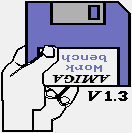
The first version of the Amiga, the Amiga 1000, needed to load Kickstart from a floppy disk into 256 kilobytes of RAM reserved for that purpose
Some games (especially Dragon's Lair) provided alternative source code for installation, in order to use the extra 256 kilobytes of RAM for game material
However, subsequent Amiga versions kept the Kickstart on a single ROM chip
When the machine started, Kickstart would display a hand holding a disk, inviting the user to insert the Workbench disk (or some other disk)
The first two sectors of the disk (512 bytes) were loaded into RAM and then control was passed to it
Most recreational software, especially during the Kickstart 1.x years, contained a boot block that loaded the rest of the software on the disk and then passed control over to it
The game or demo would then summarily take control of memory and resources to adapt itself, effectively disabling AmigaOS and the GUI would never be invoked
Therefore, most games and demos did not use the operating system at all
Alternatively, it could be said that each developer installed their own custom operating system, since any program had to install custom interrupt handlers
The boot block of a floppy disk could contain code to load the dos.library (AmigaDOS) and then abandon it, invoking the GUI
Any of these disks, regardless of their content, were known as a “DOS disk”
The boot block became an obvious target for virus developers
Created custom boot block loaders, displaying messages such as “Your disk does not have a virus” before loading the dos.library
If one installed a DOS boot block (or a covertly installed virus) on a custom disk, it could ruin the software
Amiga Software
Amiga Games
The Commodore-Amiga was an important platform in computer gaming in the late 1980s and early 1990s
Of all the 16 bit home computers, it was the most successful as a gaming machine due to its graphics and sound subsystems, which were considered ahead of their time
A game developed for the Amiga platform had better quality sound and graphics than for an IBM PC, and was a more powerful machine than its closest rival, the Atari ST
Mod based on the games music
Amiga games popularized tracker-based music, particularly the MOD file format, which enjoyed great popularity in the Demoscene community
The music of the Demoscene was influenced by the Amiga and its abundant games with lively soundtracks, made with electronic music
The music is considered an important part of the experience of Amiga games
Companies with roots Friend
The Amiga gaming scene was responsible for the rapid growth of small gaming companies including Electronic Arts who were contracted by Commodore International to produce the Amiga IFF standard file format in 1985
Electronic Arts' Deluxe Paint was included as standard for some Amigas giving greater production accessibility to the software
Other game development companies that appeared for the Amiga platform include Psygnosis (later purchased by Sony as the in-house development team for PlayStation), and a subset of Psygnosis called DMA Design (which later became Rockstar Games – the developer From the Grand Theft Auto series)
Crack intros
A crack intro, also known as a cracktro, loader or simply intro, was a short sequence of cracked software, designed to inform the user that the "cracking crew" or cracker was responsible for removing copy prevention from the software. and crack distribution
Crack intros became more sophisticated on more advanced systems such as Apple Macintosh II, Commodore-Amiga and Atari ST, as well as some IBM PC clone systems with sound cards
As a result, crack intros began to feature musical effects, colorful and high-quality scrollers
Cracking groups used intros not only to gain credit for cracking, but to advertise their various BBS, greet your friends and be known
A BBS (Bulletin Board System) it was a network software that allowed users to connect to the system (via the Internet or through a telephone line) and, through a terminal program (or telnet if it was through the Internet), perform functions such as downloading software and data, read news, exchange messages with other users, enjoy online games, read newsletters, etc
The messages were usually quite vulgar, and sometimes threatened software companies or members of another rival cracking group
Sometimes, the intros also suggested that players, in order to support better quality game designers, also purchase a legal copy of the software in question
Sometimes, along with the intros, trainers also appeared, a crack added to the game program, which allowed the player to lower the difficulty of the game, for example, selecting unlimited lives or unlimited time
Commercial Software
The Amiga was originally supported by prestigious software titles such as WordPerfect, Electronic Arts' Deluxe Paint, and Lattice C. Newtek's Video Toaster, the first all-in-one graphics and video editing package
Video Toaster was one of the few accessories for the Amiga "big box" (2000, 3000 and 4000) that used the video slot, and allowed users to turn their Amiga into a functional TV production suite
The next version of Newtek's Video Flyer made possible the first non-linear video editing program for the Amiga
The Amiga provided massively available 3D raytracing graphics with Sculpt 3D (prior to the Amiga, raytracing was only available for dedicated graphics workstations)
The Amiga was also known for its 3D rendering capabilities, adding many more titles as the years went by
Many of these titles were later ported to Microsoft Windows and continued to grow there, such as Maxon's Cinema 4D rendering software and Newtek's LightWave, which was originally part of Video Toaster
Video Toaster was also ported to the Windows platform
Even Microsoft produced software under contract for use on the Amiga, such as AmigaBASIC, a complete BASIC software development environment, with an interactive development environment (IDE)
While desktop video turned out to be an important market for the Amiga; a wave of word processors, page layout and graphics software filled professional needs
The most notable programs in word processing included Excellence, Final Writer, Prowrite and Wordworth
The design software page included Page Setter and Professional Page from Gold Disk, and PageStream from Soft-Logik
Only PageStream was ported to other platforms, and continues to be developed and supported by the developers
Graphics software included vector drawing applications such as Soft-Logik's Art Expression, Taliesin's ProVector, and Gold Disk's Professional Draw
Devpac Assembler was a professional assembler program that became the de facto standard for assembly programming
It was also able to be used to program for any other Motorola 68k based device, such as the Atari ST
It was common for programmes to be written jointly for the Amiga and Atari using Devpac on the Amiga
However, since Atari ST was the closest to the 'lowest common denominator' of the two machines, the programs were tested first on the ST
Richmond Sound Design (RSD) created both show sound control and theater sound design software, which was widely used in theaters, theme parks, exhibitions, exhibitions, shows, and the theme entertainment industry in the 1980s. , 1990 and mid-90
Many of the high-level shows, in major theme parks around the world, were controlled with Amiga
There were dozens at Walt Disney World alone and at the rest of Disney, Universal Studios, Six Flags and Madame Tussauds properties, as well as at many Las Vegas venues, including the Mirage volcano hotel and Siegfried and Roy show, the MGM Grand EFX show, The Broadway theater, London's West End, the Royal Shakespeare Company's many arenas, most theaters in Branson, Missouri, and dozens of cruise ship theaters, among hundreds of other venues
RSD purchased large numbers of used and reconditioned Amigas on the web to provide enough systems for all shows and only stopped providing new Amiga installations in 2000
There are still an unknown number of shows on cruise ships and in theme parks that are still using Amiga
Directory Opus was a file utility program
When this software was released, the most popular Amiga magazines proclaimed that it was the most important software ever released for the Amiga and that it “should be built into the operating system”
The next version of AmigaOS included a file management tool based on the DOpus
LightWave was a 3D renderer with legendary rendering quality
Most of the CGI budget relied on LightWave during the early 90s
The TV series Babylon 5 was processed with LightWave
Much shareware and free software was written for the Amiga and could be obtained through the Fred Fish serial disk or from the Aminet software archive
Because the custom chipset shared the RAM (and therefore the memory bus) with the CPU, the CPU performance increased appreciably if the display is disabled. Some software-intensive processors, such as 3D processors, turned off the screen during calculations in order to gain speed
Demos
The Amiga was the focus of the “demo scene”, the Amiga thrived in public domain, freeware and non-profit developments
The demo scene spearheaded the development of multimedia programming techniques for the Amiga, in such a way that it was the setting for the latest visual, sound tricks and 3D algorithms of the demo scene to end up being used in the development of computer games
Decrunching
The Amiga's floppy drive allowed only 880 kilobytes on a single disk, which was comparable to the memory of most Amigas (usually 512 kilobytes, often 1 megabyte)
In order to increase performance, Amiga was one of the first computers to use compression/decompression techniques on a regular basis
The disk drive had a slow transfer rate, such that using processor-based decompression could lead to faster load times than loading uncompressed data from disk
Early implementations of decompression code quickly wrote variable values to a video display register, causing the scan lines of the screen to break up into multiple segments of colorful noise, a technique that would be improved by decrunching
This psychedelic effect, very easy to implement, but impossible for any other computer's hardware. The use of decrunching became so ubiquitous that the effect was a standard prelude, expected at the start of almost any game or demo
Amiga Community
When Commodore went bankrupt in 1994, there was still a very active Amiga community, and for that reason the platform continued to be supported long after the major commercial vendors abandoned it
The most popular Amiga magazine, Amiga Format, continued to be published until 2000, six years after the last Amiga unit was sold
Many fans believed that the Amiga was unique and better than other platforms, such as the AmigaOne (made by the British firm Eyetech), despite using slower hardware than a PC of the same price
One of the reasons for this loyalty was due to the robustness of the machine at that time: its operating system was stable, compact, efficient and multitasking, it was relatively easy to program, the software had relatively easy access to the hardware (the motherboard It was set up so that software could be coded specifically for hardware), there was a lot of quality software, and it was an affordable multimedia machine for its time
However, as time went on, the hardware was outclassed and, as the PC improved in software and hardware, the Amiga began to look dated
Despite this, its strong set of users continued to produce software and squeeze out everything they could for the machine
Amiga users managed to squeeze every drop of performance and capability out of their machines, with software and hardware expansions that improved their capabilities
Even in mid-2006 there was enough demand for hardware expansions to sustain some minority manufacturers
Can currently be found active communities like for example the Club de usuarios de Commodore Amiga – Argentina or Commodore Spain or also of AmigaOs


